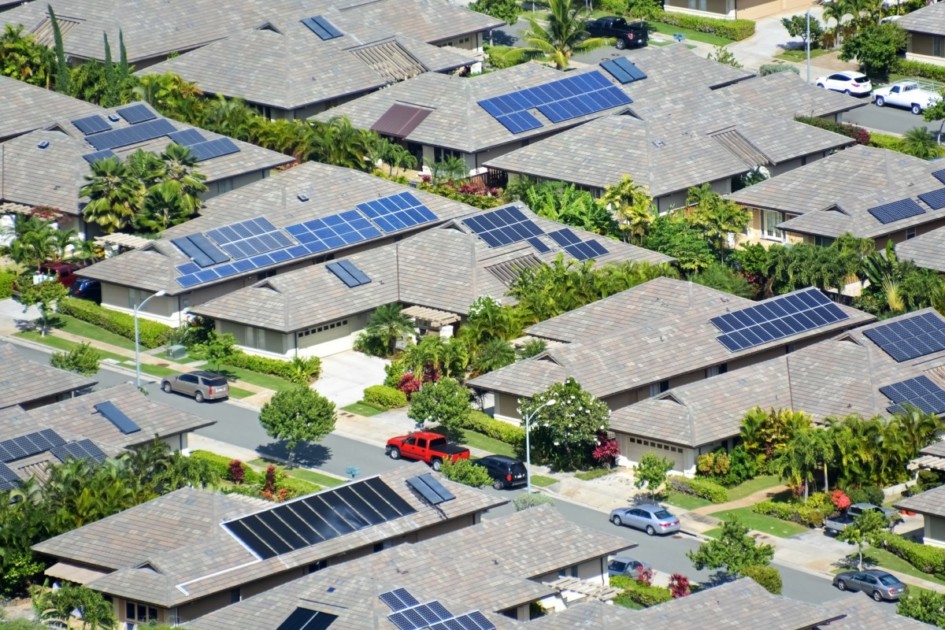The science behind climate change can be overwhelming and complex. When it comes to its impact on the future, much is still undetermined. So how can you take control and do your part to help slow the impact of climate change? While a lot of factors are out of our control, simple changes at home can decrease greenhouse gas emissions and reduce your carbon footprint. Whether it’s insulating your home, planting a garden, or switching to renewable energy sources like solar panels or natural gas, every effort counts. Read on to find out what a carbon footprint is and how to reduce your carbon footprint at home.

What is a carbon footprint?
Carbon footprint – we’ve all heard this buzzword. As you probably know, the smaller your carbon footprint is the better it is for the planet. But what exactly is a carbon footprint? A carbon footprint is an individual, group, or company’s total amount of greenhouse gasses emitted into the atmosphere. These gasses include carbon dioxide (the gas most commonly emitted by humans), methane, and fluorinated gasses, all of which are both direct and indirect results of transportation, consumption of food and consumer goods, and home energy usage emissions. These gasses trap heat in the atmosphere, causing a rise in global temperature.
The average American’s carbon footprint is 16 tons of carbon-equivalent emissions annually, 12 tons more than the global average. The Nature Conservancy recommends that the global average for an individual’s carbon footprint drop below 2 tons per year by 2050.
To calculate your carbon footprint, you’ll need to measure the following:
- Approximately how many miles you travel by car, bus, train, and plane
- The energy usage in your home
- What types and how much food you consume
- Shopping habits
No matter what you score, it’s great to have a baseline and know where you can make improvements and what impact those improvements will have on your carbon footprint.
Benefits of reducing your carbon footprint
Protecting the environment and creating a better future are obvious benefits to reducing your carbon footprint. Even the smallest changes – perhaps swapping your current showerhead for a water-saving one, or turning the lights off when you leave a room – can make a big difference towards helping the environment in the long term.
Reducing your carbon footprint also has the potential to save you money. Here are some of the easiest ways you can start to reduce your carbon footprint at home and do your part to combat climate change.
How to reduce your carbon footprint at home
1) Insulate your home
Keeping your home warm in the winter and cool in the summer can consume a lot of energy. Hiring a professional to add more insulation in your loft, walls, and around doors, air ducts, and windows is an easy way to reduce your carbon footprint at home. Insulating your home will help retain the desired temperature without using excess energy. You can also reduce drafts by sealing any air leaks with caulk and weather stripping.
Insulation helps decrease your monthly energy bills, too. In fact, homeowners can save an average of 15% on heating and cooling costs by sealing their home and adding more insulation. “Air sealing and insulating is the most effective way to reduce the cost of heating and cooling your home while drastically improving the comfort,” says Anthony Stonis, President of Building Energy Experts. “First, it’s important to find and seal any gaps and cracks in your home with cell form or caulk. This process is called air sealing. Next, add insulation. Blow-in cellulose insulation is the most environmentally-friendly choice.”
2) Switch to renewable energy
Coal-fired power plants – facilities that use coal in order to generate electricity – are responsible for over half the electricity in the United States. Lessen your coal dependency and choose an energy provider that sources its electricity from wind, solar, geothermal, or hydroelectric energy. You’ll decrease your household emissions and save money on energy bills.
“Choosing to transition your living space to renewable energy is not only good for the planet, but it’s also good for your wallet,” says Biofriendly, whose goal is to help humanity tackle environmental damage. “Find ways to invest in cleaner energy to reduce greenhouse gas emissions, improve your home’s green value, and enhance your resiliency during unexpected outages.”
If you live in an area that receives a considerable amount of sunlight – like Oahu, HI, or El Paso, TX – switching to solar power might be the right option for you to reduce your carbon footprint at home. The upfront costs of solar panels can be steep, however, you’ll end up saving money by using less electricity in the long run. There are also federal and state government tax incentives in place for the carbon offsets from renewable energy.

3) Buy energy-efficient appliances
Thinking about replacing any of your household appliances, perhaps your furnace, air conditioning unit, or refrigerator? When you’re deciding between models, make energy efficiency a priority to help reduce your carbon footprint at home. All ENERGY STAR-certified products have been tested to ensure they meet the U.S. Environmental Protection Agency’s (EPA) strict energy-efficiency specifications to help you save energy and money. These certified appliances can save a typical household about $450 on energy bills without sacrificing quality. Many utility companies also offer rebates on ENERGY STAR-certified products.
It’s never too late to reap the benefits of switching to energy-efficient appliances. “Pledging an oath to a healthier future for our planet starts at home, but when it comes to energy-efficient appliances, not all buyers believe the hype,” says Don’s Appliances. “From increasing your home value to lowering annual appliance costs and shrinking the size of your carbon footprint, more homeowners are starting to realize the incentives of switching to high-performance appliances.”
4) Schedule an energy audit
A home energy audit helps homeowners determine how much energy their home uses.This includes looking into where it’s losing energy and what areas require more attention. “If you’re experiencing high bills or uncomfortable temperatures in your home, the first thing you should do is schedule an energy audit. Why guess what’s causing these things to happen?” says Sean McGraw, the founder and visionary of FOR Energy, an energy audit provider. “An audit tests your home for leakage points, tests your larger appliances and insulation levels, and gives you a complete roadmap to energy savings through home efficiency.”
“The average person can easily save 20% or more on their energy bill by conducting a home energy audit and addressing any energy hogs it finds,” shares Thad Warren from EnergyBot, an online energy marketplace that helps compare energy rates. “The upfront cost is relatively low, especially when you can take advantage of incentive programs and rebates. A free usage comparison tool is a great place to start to benchmark your energy usage against similar homes and let you know if you are a good candidate.”
Some local utility companies also offer free energy audits to help homeowners discover where they can improve efficiency, save energy, and reduce their carbon footprint at home. If your utilities company doesn’t offer this service, you can hire a professional energy auditor to assess your home and find areas that need improvement.
5) Use less water
Processing, receiving, and heating water in our homes doesn’t just happen – it takes energy and resources. Using less water is a simple way to reduce your carbon footprint at home and help the environment. Changes like taking shorter showers, turning off the tap while you’re brushing your teeth, and installing a water-saving showerhead can help to conserve water without a significant change to your daily routine.
Oasense, a company that offers high-pressure showerheads that help conserve water, suggests checking your household habitual water wastage. “Habitual water wastage is a term used to describe the water that drains away in your home unused. This water-saving practice is already prevalent in drought-affected areas, and our studies have shown that this can help to reduce more than 50% of the water and energy used by your shower.”
Here are just some of the changes you can make to save money, conserve water, and reduce your carbon footprint at home:
- If you find a leak, maybe from a faucet or the toilet, try to fix it as soon as possible to avoid wasting more water. Leak detectors can notify homeowners of problems before they become costly repairs.
- Only run the dishwasher and washing machine with a full load.
- Don’t overwater your lawn. Run sprinklers in the morning to avoid rapid evaporation from the midday heat.
- Insulate exposed pipes in the attic or basement. This will shorten the time it takes the water to heat up before use.
- Install a rain barrel to catch rain for outdoor watering.

6) Turn off your lights and unplug devices
Turning off your lights when you leave a room is an easy and cost-effective way to save energy and lower utility bills. With incandescent lights, switching them off when you leave the room, for even just one minute, can make a difference. If you use fluorescent bulbs or CFL lighting, the general rule of thumb is to turn off the lights if you plan to leave the room for more than 15 minutes. It may take time to build this habit, but it will be worth it in the long run.
Electronics that are plugged in, even when turned off, are always using energy and are adding to your carbon footprint. Homes are filled with electronic devices and electrical appliances that rarely get unplugged, like a TV, desktop computers, or phone chargers. And while these devices consume only a small amount of energy on their own, a house full of them can begin to add up.
Unplugging appliances and electronics will not only reduce your carbon footprint at home but can also save money – about 5 to 10 percent on your electric bill. Consider using an electricity monitor to determine how much electricity your appliances and electronics use.
7) Go digital
Consider cutting as much paper out of your life as possible to reduce your carbon footprint. Documents that previously had to be printed – i.e. receipts, bank records, and bills – can now be found electronically. Be sure to sign up for e-billing and back-up important files and documents on an external hard drive or take advantage of cloud technology.
8) Reduce, reuse, and recycle
Reduce, reuse, and recycle is a well-known phrase. However, not enough of us are practicing it. In the U.S., we produce 3x as much garbage as the global average. Recycling diminishes the need for raw materials, saves energy and fossil fuels, and diverts materials away from landfills and incinerators. Here’s what you can do to reduce your household waste and practice the three R’s:
- Reduce: Only buy what you need, choose products with less packaging, look for items you can reuse, and buy in bulk.
- Reuse: Buy reusable shopping bags, use a refillable water bottle, donate working electronics you no longer use, donate clothes, furniture, and household items, reuse containers for leftovers.
- Recycle: Separate trash from items that can be recycled. This includes paper, glass, cardboard, aluminum, and lead batteries.
“Recycling is more than just putting an item in the correct bin. It’s understanding the value of the raw materials, energy, and resources that went into creating the object,” says Everyday Recycler, a resource for people to find recycled gifts and products. “Recycling reuses resources while saving energy and reducing our overall impact on our planet. When learning to recycle, we suggest taking small steps to help you succeed. Try starting with one material like paper or plastic and learning what items can and cannot be recycled. Then move on to the next material. Before you know it, you’ll be a recycling pro.”
9) Waste less food
Nearly 40% of all food in the United States goes to waste, most of which turns into methane at the landfill. Be sure to plan your meals ahead of time, freeze what you can’t use immediately, and eat leftovers.
Composting, a natural process of breaking down materials to create nutrient-rich soil, is a great way to reduce your carbon footprint at home while decreasing the amount of food that ends up in the landfill. It’s also a great fertilizer for your houseplants and your gardens. Anything that decomposes – such as banana peels, coffee grinds, or eggshells – can be added to your compost pile.
Getting started is sometimes the hardest part. “Composting can seem complex and challenging due to a lack of general knowledge around how to start and how it works,” says Partage, who creates high-quality, eco-friendly products for everyday use. “The benefits of composting outweigh its complexity. First, select the suitable compost method for you. You can compost from your backyard or living room if you have a smaller home. Once you’ve decided which method you want to go with, keep your vegetable and fruit leftovers and store them in your compost. After that, make the compost mix and wait.”
10) Upgrade to smart lighting
Smart lighting is a modern and convenient way to reduce your carbon footprint at home. “All homes can benefit from a new smart lighting system by providing several different benefits depending on which type of system you choose,” says Eric Rasmussen, CEO of Intuitive AV, a technology consultant and provider. “There are a variety of different types and brands of systems available for smart LED light bulbs for increased energy efficiency, or app /voice-controlled light switches and dimmers for improved automation and control. With so many options available, many homeowners choose to work with home automation professionals to discuss what features will bring the most benefits and value to your home based on your goals for your smart lighting system.”
11) Design an edible landscape
Vegetable gardens are a great way to reduce your carbon footprint at home. Growing your own food removes the resources it otherwise takes to produce, ship, market, and deliver groceries. You can find small raised bed kits at garden centers and big-box stores, or you can opt to build your own. Be sure to research which produce grows best in your climate.
“Other than reducing the amount of food that ends up in the landfill, another great reason to grow veggies and herbs is to have a constant supply of fresh options,” says Tilly Design, a landscape design company. “There’s nothing worse than having to throw out the store-bought lettuce because you left it in the fridge for too long – if it’s growing outside you can just snip a few leaves and instantly have a fresh salad. The same is true for herbs. Leave your growing herbs right outside your kitchen door for easy access and avoid trips to the grocery store. You’ll avoid having to buy a whole bundle, much of which will go to waste.”

12) Install a programmable thermostat
A programmable thermostat is a Wi-Fi-enabled device that automatically allows homeowners to adjust the temperature for peak energy efficiency. It can also be adjusted while you’re away from home, perhaps at work, running errands, or on vacation. Turning the thermostat down just 2 degrees cooler in the winter and 2 degrees warmer in the summer can save 2,000 pounds of CO2 each year. You’ll also find that some state and local governments offer tax rebates when you install a smart thermostat, and energy providers sometimes offer discounts on the device itself.
Experts at Carolina Custom Sound explains how homeowners can reap the benefits of smart thermostats. “Are smart homes the secret to lowering global carbon emissions for good? Altogether, homeowners have grown conscious about when and how to use their appliances, but research shows passive energy consumption is still a substantial part of the problem. One of the biggest offenders is home temperature management, but smart thermostats offer a state-of-the-art solution to the problem with extra perks that make the transition simple and delightful.”
13) Upgrade your AC, washer, and dryer
Nearly 20% of Americans live in homes with inefficient HVAC systems that cost an extra $882 annually on average to cool their homes. This is about four times the amount of more efficient systems in similar homes. Upgrade to an energy-efficient model and see the dramatic impact on your energy consumption without sacrificing comfort.
A high-efficiency washer and dryer can also help reduce your carbon footprint at home. Albert Lee Appliance provides insight into the impacts of using a gas dryer at home. “If you’re using a gas dryer, your home can turn into an environmental hazard. Harmful emissions from gas dryers contribute upwards of 5 percent of the annual rate of carbon dioxide emissions, increasing your home’s carbon footprint every time the dryer is used. The good news is users can start saving 20 percent on energy immediately and cut emissions completely by making the switch to an electric heat pump dryer.”
Disclaimer: Redfin is not affiliated with nor endorses or guarantees any of the products or services mentioned.
The post 13 Ways to Reduce Your Carbon Footprint at Home appeared first on Redfin | Real Estate Tips for Home Buying, Selling & More.
from Redfin | Real Estate Tips for Home Buying, Selling & More https://ift.tt/qV5WTw6


No comments:
Post a Comment